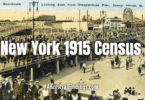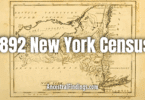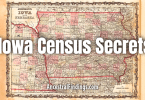The 1900 U.S. Census marks the beginning of a new era. It was the first census of the 20th century—and it knew it. By 1900, America had changed dramatically. Cities were growing faster than ever. Immigrants from Italy, Poland, Russia, and other parts of Eastern Europe were arriving in record numbers. The American frontier was nearly closed. Families were moving, industries were booming, and the pace of life had quickened. This census tried to capture all of that.
And for genealogists, it’s one of the richest federal records available. With just one census page, you can estimate a birthdate, find an immigration year, see how many children a woman had, and even figure out how long a couple had been married. In a single glance, you get a snapshot of relationships, household structure, and a family’s trajectory at the start of a new century.
Why the 1900 Census Stands Out
Unlike earlier censuses, the 1900 census didn’t just ask for ages—it asked for birth months and birth years. That detail alone helps solve age inconsistencies across previous decades. If someone’s age is unclear in earlier censuses or differs from other records, this one usually helps anchor it.
It also asked each married woman how many children she had given birth to—and how many were still living. That simple question can be a breakthrough when you’re trying to identify missing children, understand gaps between siblings, or discover possible infant deaths that weren’t recorded elsewhere.
Another important addition was the number of years a couple had been married. This often confirms (or corrects) estimated marriage dates and may guide you toward a marriage license or church record.
Tracking Movement and Migration
The 1900 census includes birthplace not just for the person being recorded, but also for their mother and father. That wasn’t new—it had been included in earlier censuses—but what made it more powerful in 1900 was how it combined with other questions. If someone was foreign-born, the census asked for the year they immigrated to the United States, how long they had been in the country, and whether they had become naturalized citizens.
For immigrant families, this is a turning point in tracing movement. If a family arrived in 1884, you can now search passenger lists, port records, or naturalization files using that year as a guide. The “years in the U.S.” question also helps verify timeline consistency across generations.
A Snapshot of Family and Work
Occupations were listed clearly in 1900, along with whether each adult was employed for all twelve months. You can see if someone was out of work for part of the year and whether they owned or rented their home. In some cases, the census even noted if the home was a farm.
The combination of employment, household structure, and property status offers a fuller picture of a family’s stability, lifestyle, and community role. You might see an aging father working as a laborer while two grown sons are now the primary earners—or a widowed mother supporting a household by working as a seamstress.
The Historical Moment
Taken on June 1, 1900, this census captures families just before the explosion of modern life in the U.S. Teddy Roosevelt wasn’t yet president. Automobiles were a curiosity. Electricity hadn’t reached rural America. But change was coming. This census shows people who grew up in the shadow of the Civil War but were now raising children who would go on to serve in World War I.
It’s also one of the last censuses to show a generation born in the early 1800s still living—especially those in their 70s, 80s, and 90s. For many researchers, this is the final census appearance of a great-great-grandparent or the only record that lists their exact birth month or year.
Where to Watch for Errors
Like all historical records, the 1900 census isn’t perfect. Enumerators sometimes guessed at ages, or recorded the wrong birth year—especially for older people or immigrants with accents. Children may have been left off the schedule if they were living with relatives or hired out as domestic workers. And the number of children born versus children living was sometimes recorded inconsistently, especially if the respondent misunderstood the question.
That’s why it’s helpful to compare this census with earlier and later ones—especially 1910, which repeats the childbearing and immigration questions, and 1880, which helps you trace back married couples to their earlier households.
Tips for Researchers
If you’re using the 1900 census in your research, take your time with each line. Write down full birth months and years. Track immigration years across family members—if one says 1885 and another says 1883, you may be able to pinpoint a window. Compare the number of children listed in the household to the number the mother reported giving birth to. Is someone missing?
Look closely at neighbors, too. Extended families often lived nearby—especially if they had immigrated from the same region. I’ve seen siblings listed two pages apart, living on the same block under different surnames due to marriage. Those little connections lead to big discoveries.
If a woman is listed as having given birth to six children, but only three are in the home, begin looking for deaths, burials, or other households with familiar names and birthplaces. The 1900 census quietly tells you about children you may never have known to look for.
Final Thoughts
The 1900 census isn’t just a set of answers—it’s a doorway. It connects the 19th century to the 20th. It gives us dates, timelines, and relationships we’ve never had in a census before. For researchers, it’s one of the most detailed, humanizing records the federal government ever produced.
If you’ve ever felt like you didn’t know who someone really was—or where they came from—this census helps you start putting the pieces together. It shows marriages taking root, families expanding, and immigrants establishing new lives. It’s not just about counting people. It’s about understanding who they were when the century turned—and how their stories continued through the decades that followed.
Take your time with this one. It has a lot to say.






